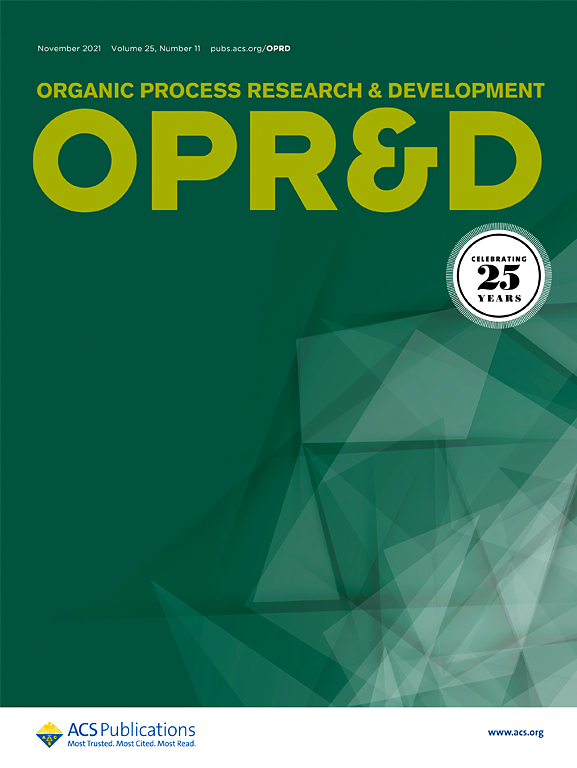Optimizing the CHF6523 Isocoumarin Core Scaffold: From the Preclinical Stage to Large-Scale Production
IF 3.5
3区 化学
Q2 CHEMISTRY, APPLIED
引用次数: 0
Abstract
The structure of the new active pharmaceutical ingredient (API) PI3Kδ inhibitor CHF6523.02, identified for the treatment of exacerbating chronic obstructive pulmonary disease (COPD) in patients, is reported. The described molecule bears an isocoumarin core scaffold, whose synthetic route scalability is critical for API process development and the successful establishment of a multikilogram synthesis route. In this paper, we describe the process research and development work for the isocoumarin scaffold synthetic procedure, exploiting a novel and efficient electrophilic cyclization step, to provide large quantities of the product required to support the API candidate’s clinical studies.

CHF6523异香豆素核心支架的优化:从临床前期到大规模生产
新活性药物成分(API) PI3Kδ抑制剂CHF6523.02的结构被确定用于治疗加重型慢性阻塞性肺疾病(COPD)患者。所描述的分子具有异香豆素核心支架,其合成路线的可扩展性对于API工艺开发和多公斤合成路线的成功建立至关重要。在本文中,我们描述了异香豆素支架合成过程的研究和开发工作,利用一种新颖高效的亲电环化步骤,提供大量所需的产品,以支持API候选药物的临床研究。
本文章由计算机程序翻译,如有差异,请以英文原文为准。
求助全文
约1分钟内获得全文
求助全文
来源期刊
CiteScore
6.90
自引率
14.70%
发文量
251
审稿时长
2 months
期刊介绍:
The journal Organic Process Research & Development serves as a communication tool between industrial chemists and chemists working in universities and research institutes. As such, it reports original work from the broad field of industrial process chemistry but also presents academic results that are relevant, or potentially relevant, to industrial applications. Process chemistry is the science that enables the safe, environmentally benign and ultimately economical manufacturing of organic compounds that are required in larger amounts to help address the needs of society. Consequently, the Journal encompasses every aspect of organic chemistry, including all aspects of catalysis, synthetic methodology development and synthetic strategy exploration, but also includes aspects from analytical and solid-state chemistry and chemical engineering, such as work-up tools,process safety, or flow-chemistry. The goal of development and optimization of chemical reactions and processes is their transfer to a larger scale; original work describing such studies and the actual implementation on scale is highly relevant to the journal. However, studies on new developments from either industry, research institutes or academia that have not yet been demonstrated on scale, but where an industrial utility can be expected and where the study has addressed important prerequisites for a scale-up and has given confidence into the reliability and practicality of the chemistry, also serve the mission of OPR&D as a communication tool between the different contributors to the field.

 求助内容:
求助内容: 应助结果提醒方式:
应助结果提醒方式:


